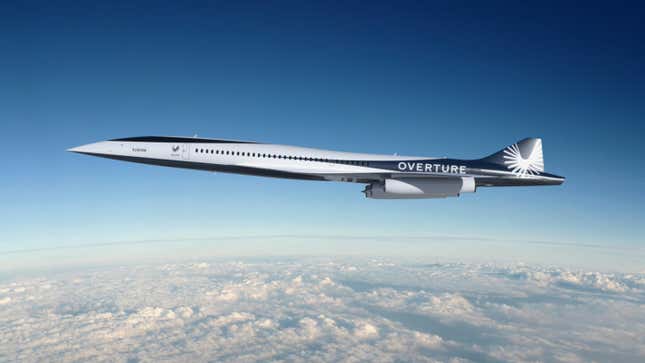Private aerospace company Boom Supersonic got its XB-1 demonstrator aircraft in the air and back down again last week, completing the carbon fiber plane’s first successful flight. It hasn’t broken the sound barrier yet, but the new plane is notable for setting the stage for a fuel-efficient supersonic passenger airliner Boom is hoping to launch in the future.
With a conventional jet engine, carbon fiber composites, and an augmented reality heads-up display in the cockpit for its human pilot, the aircraft took to the skies from the Mojave Air & Space Port in Mojave, California, on Friday. The historic Bell X-1—the Jetsons-looking aircraft in which Chuck Yeager broke the sound barrier in 1947—made its first supersonic flight just down the road, above Rogers Dry Lake.
The 62.6-foot-long (19-meter) demonstrator met its test objectives, achieving an altitude of 7,120 feet (2,170 meters) and speeds of 273 miles per hour (439 kph). Check out video of the Boom XB-1’s first flight below; for the impatient, the aircraft takes off around 1:10.
“I’ve been waiting over 20 years for an environmentally friendly successor to Concorde and XB-1’s first flight is a major landmark towards my dreams being realized,” said Mike Bannister, formerly the Chief Concorde Pilot for British Airways, in a Boom press release. “When I last flew Concorde in 2003 I knew that this day would come. The first flight of the XB-1 supersonic demonstrator is a significant achievement toward making sustainable supersonic flight a reality.”
Indeed, sustainability—economic sustainability—was the problem with Concorde, a supersonic passenger aircraft that could fly from NYC to London in under three hours. According to the Museum of Flight, the costs of supersonic travel were rising well before the fatal crash in 2000 that killed 113 people. Besides that, the planes’ earsplitting sonic booms meant the aircraft could only go supersonic over the open ocean. Cities issued noise complaints about the aircraft, and today commercial air travel is entirely subsonic.

Boom hopes to develop its Overture airliner to fly using sustainable aviation fuels (SAF), made from recycled carbon dioxide, forest residue, algae, and more. But as Gizmodo reported in 2021, though the company says the planes will be “optimized” for such fuels, it doesn’t promise the planes will run on it. Overture currently just a concept; Boom advertises that it is expected to carry 64 to 80 passengers at speeds of Mach 1.7. In 2021, United Airlines agreed to purchase 15 supersonic aircraft from Boom with options to purchase dozens more. The Washington Post reported that Boom is looking to debut the Overture jet in 2029.
The Boom XB-1 is not the only supersonic demonstrator hitting the skies in 2024. NASA’s X-59 (also known as the Quesst mission) is expected to make its first flight sometime this year. Unlike the Boom demonstrator, the Quesst mission is trying to achieve sonic boom-less flight, reducing the noise pollution to a “sonic thump,” as the agency describes it. The NASA plane has a more unusual design than the Boom plane (which looks fairly ordinary as far as jets go) and its mission is expected to run through 2027.
The Federal Aviation Administration does not allow civil aircraft to travel at speeds exceeding Mach 1 over land. Clearly, that will have to change if the Boom team wants its aircraft to reach Mach 1.7 and achieve significantly shorter cross-country flights.
More: United’s Supersonic Jet Sustainability Claims Sure Sound Suspect




















+ There are no comments
Add yours